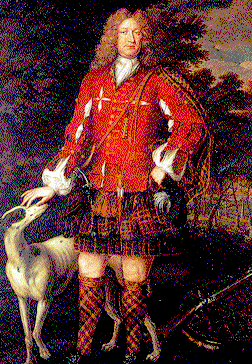KENNETH
SUTHERLAND - 3RD SUTHERLAND LORD OF DUFFUS
by Gordon Douglas Duffus
The title "Lord of
Duffus" began with Freskin de Moravia, the progenitor of
the houses of Sutherland and Murray. Freskin, a soldier in
the army of King David the Saint, marched in King's army when
he put down the last rebellion of the men of Moray.
In 1705,
Kenneth Sutherland succeeded to the title and lands of Duffus
upon his father's death. The property, at this time, was
either in the hands of Kenneth's brother James or was heavily
mort- gaged to Dunbar of Thunderton. Revenue would be
nonexistent or very slow in coming.

At the time of Kenneth's father's death, Kenneth was out of
the country on "Crown business inthe West Indies."
This circumstance necessitated an extension of the legal
period "for entering asheir to the estate." Upon
his eventual return to Scotland, Kenneth was allowed to
assume the title Lord of Duffus.
In
1707, Kenneth took his seat in Parliament and cast his vote
for "The Union." In 1708 he married Charlotta
Christiana, the daughter of Eric de Sioblade, the Governor of
Gottenburg. Due to the poor financial situation which he
inherited, Kenneth was forced to seek employment in Queen
Anne's navy, raising to the rank of Captain. On June 28,
1711, while on patrol in the West Indies, Kenneth encountered
eight French privateers and the fight was on. After "a
desperate struggle," during which Kenneth received
"five bullets in his body," he was forced to
surrender his forty-six gun frigate to the enemy.
In August
of 1715, Kenneth was invited to a meeting by the Earl of Mar.
The meeting was set for the forest of Braemar and among the
invited guests were the Marquesses of Tullibardine and
Huntly, George Keith, the Earls of Erroll, Kilsyth, the Lords
Rollo, Drummond, and Ogilvy, General Hamiliton, Gordon of
Auchintoul, Campbell of Glendaruel, Glenngarry, Lyon of
Auchterhouse, and Auldbar. Mar choreographed the
entertainment and concluded a general hunt with an
empassioned speech in favor of a Rising for the House of
Stuart. The lighted- hearted proceedings took a more serious
turn when plans were formulated for each participant who then
re- turned to their respective spheres of influence to put
the plans into effect. Around this time, Kenneth's
contemporaries described him as being "boastful and
unstable."
Kenneth
honored his Jacobite commitment when he and his kinsman, the
Mackenzie Earl of Seaforth, marched into Tain at the head of
five hundred Mackenzies, MacDonald's, and Chisholms. The
Chevalier, St. George, was proclaimed as King James VIII at
the mercat cross and Kenneth's future would now depend on the
outcome of the rebellion
After
the taking of Tain, Kenneth attempted to get the Lairds of
Culloden and Kilravock to surrender their houses and arms to
the rebels. Culloden and Kilravock held out and the attempt
failed. Seaforth and Kenneth started to march their clansmen
south to meet Mar and the Jacobite army at Perth but were
delayed by the inclement weather.They did succeed, however,
on being on time for the Battle of Sherriffmuir. During the
confused fighting, Kenneth begged the Earl of Seaforth to
allow him to lend their combined force to a charge. The
command was never forth- coming and the Jacobite force,
though not actually beaten, withdrew from the field. As they
jour- neyed north the army began to dwindle away until there
was nothing left. Mar had lost the one truly great
opportunity to regain the throne for the Stuarts. The
rebellion foundered and then collapsed completely.
The
rebellions' leaders, being financially better off than the
men under their command, left the clansmen behind and
scattered throughout the kingdom in their respective bids for
freedom. Kenneth ran north, passing his castle and estate at
Skelbo and probably learned that his property had been seized
by his feudal superior, the Earl of Sutherland, who was a
staunch Hanoverian. Kenneth succeeded in reaching Caithness
where he boarded a ship for Sweden and safety.While in Sweden
Kenneth learned that the British Government was actively
searching the continent for him. He gained an audience with
the British minister in Stockholm and advised that he was
return ing home to surrender himself within the terms of the
Amnesty Agreement. While traveling to the channel ports,
Kennth was seized and imprisoned on orders of the British
resident at Hamburg. He was kept locked away until after the
amnesty date had expired at which time he was sent, in
chains, to the Tower of London. On the 4th of October, 1717,
never having stood trial Kenneth was released from captivity.
Due
to his naval experience, Kenneth was invited to Russia to
perform the duties of a naval advisor to the Czar. He
departed Scotland but returned in 1733, having less than one
year to live. His return and the return of other Jacobite
adherents raised a question to the legal status of the
attainted noblemen. Lord Chancellor Hardwick addressed the
problem: "To Lord Duffus and several others have only
pardoned the pains of death execution and imprisonment of
persons, and it is extremely doubtful whether any civil
capacity could be restored."
Kenneth Sutherland, 3rd Sutherland Lord Duffus, died on March
30, 1734 devoid of his title, his lands, and any dreams he
may have had for a Stuart restoration. His son, Eric,
attempted to have the title bestowed on himself but met with
opposition from the House of Lords. He used the the title
anyway!
contents|crest|dedication|family trees|
|scottish
church records|tartans
© 1998 David
Duffus. All rights reserved.
Design by
David Duffus
